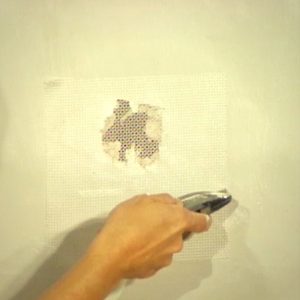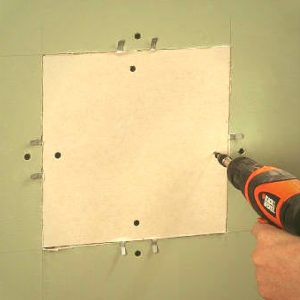What You Should Know About Repairing Drywall
Repairing drywall, like most home repair jobs, is more satisfying if you do it right the first time. When repairing drywall, patience really pays off. Allow your repairs to dry thoroughly between applications, and provide adequate support for large patches. Always observe proper safety precautions.
What You’ll Need for repairing drywall
 For drywall repairs larger than scratches and nail holes, you will need a few tools, including: a utility knife, electric drill, Phillips head screwdriver, saw, a large putty knife, and a sander or fine-grit sandpaper.
For drywall repairs larger than scratches and nail holes, you will need a few tools, including: a utility knife, electric drill, Phillips head screwdriver, saw, a large putty knife, and a sander or fine-grit sandpaper.
You will also need one or more of the following materials:
- Surfacing Compound – Superficial repairs like nail holes, small cracks, and dents can be repaired with a lightweight surfacing-compound. Smaller repairs can be completed quickly, dry in a few minutes, and can be sanded with fine grit sandpaper.
- Spackling Paste – Spackling paste is designed to fill larger holes with a layering technique over multiple applications. The final patch is allowed to dry completely and then sanded.
- Latex Caulk – Use latex caulk on gaps and large cracks where there can be play or instability. Caulk should be applied carefully and smoothly because it can’t be sanded, and although it can be painted, imperfections will be visible.
- Patch Kits – Drywall patch kits are available in a number of sizes up to about eight inches. They can be applied to flat walls, ceilings, and both inside and outside corners. They will conform easily to the surface you are trying to repair, and make a strong, permanent patch. Patch kits usually include the patch only; spackling compound is typically sold separately. Repairs that are beyond the scope of patch kits will require spackling paste, ¾-inch plywood to support the patch, scrap drywall to cover the hole, self-adhesive fiberglass drywall tape, and drywall screws (1 ¼-inch and 3-inch).
Evaluate the Job
Damaged drywall falls into a number of categories: small nail holes and scratches, narrow cracks, medium holes, and large holes. Nail holes, small scratches and narrow cracks can be repaired without providing support for the repair, while medium size and large holes will have to be patched using mesh or plywood for support.
![just use spackle when repairing drywall nail holes]() Small Job Drywall Repair
Small Job Drywall Repair
If you are planning on filling nail holes and small scratches only, then a putty knife, small container of surfacing compound, and fine grit sandpaper will probably be all you need.
- Fill the hole or scratch, allow to dry, and sand smooth
- If you are repairing a narrow crack, widen the crack slightly and remove the loose material, then fill with surfacing compound. Widening the crack will help the surfacing compound make a stronger bond.
![use mesh tape to patch medium sized holes in drywall]() Medium Size Job Drywall Repair
Medium Size Job Drywall Repair
Drywall patch kits are available in sizes up to about eight inches and are an easy solution for medium size jobs.
- Select a patch that is at least one inch larger than the hole you are trying to repair, and apply with water.
- Allow the patch to partially dry and then depress the center, creating a cavity.
- Allow the patch to dry completely and fill the cavity and surrounding patch with spackle. This may require more than one application of spackle. If so, allow each application to dry completely before continuing.
- Once the spackle has dried, sand it flush with the wall, prime, and paint.
![cut and replace larger sections of damaged drywall]() Large Job Drywall Repair
Large Job Drywall Repair
- Cut a rectangle around the damaged area large enough to expose the studs on either side.
- Use a carpenter’s square to make an even outline, and cut the drywall with a drywall or utility saw.
- Affix strips of 3/4″ plywood along the back of the rectangular opening for support using three-inch drywall screws. When you’ve finished, there should be support for the patch on either side from exposed wall studs, and in the center from plywood strips.
- For the patch, cut a piece of drywall the size of the rectangular opening. Use 1¼-inch drywall screws to screw the patch into the studs and plywood. Position the screws at least a quarter of an inch in from the edge of the drywall patch on all sides to avoid crumbling.
- Measure and cut strips of self-adhesive fiberglass drywall tape and install them on all four sides of the patch.
- Using a putty knife, apply joint compound to cover the patch.
Whenever possible, allow your patch to cure overnight before painting. When sanding, stand back periodically to check your work, and always provide proper ventilation and adequate light.



 Small Job Drywall Repair
Small Job Drywall Repair Medium Size Job Drywall Repair
Medium Size Job Drywall Repair Large Job Drywall Repair
Large Job Drywall Repair